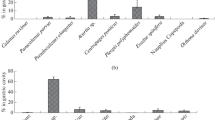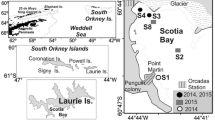Abstract
The annual cycle of abundance and distribution of the scyphozoan medusae Aurelia aurita and Cyanea capillata was studied in the Bornholm Basin (central Baltic Sea) in 2002. Seasonal changes in prey composition and predatory impact were investigated by analyzing stomach contents. A. aurita occurred from July to November, with a maximum mean abundance of 2.3 ind. per 100 m3 in August, whereas C. capillata was caught in much smaller numbers from July to September. No ephyrae of either species were found; therefore, advection of medusae from the western Baltic Sea is assumed. From July to October, ~80% of A. aurita medusae was distributed in the upper 20 m above the thermocline, whereas C. capillata occurred only in the halocline below 45 m. A. aurita did not migrate vertically and fed mainly on the most abundant cladoceran species Bosmina coregoni maritima. Further prey organisms were the cladocerans Evadne nordmanni and Podon spp., mollusk larvae and copepods. Copepod nauplii and copepodite stages I–III were not eaten by the medusae, neither were fish eggs and larvae used as prey. Based on mean medusa and zooplankton abundance from the upper 20 m, the predatory impact was very low. In August, when mean abundance of A. aurita was highest, only 0.1% of the copepod and 0.5% of the cladoceran standing stock were eaten per day. However, in regions with higher medusa or lower zooplankton abundance, up to 7.9% of the cladoceran standing stock was consumed per day. Hence, A. aurita did not regulate the zooplankton community in the Bornholm Basin, and fish larvae did not suffer from competition with and predation by the medusae.



Similar content being viewed by others
References
Arai MN (1997) A functional biology of Scyphozoa. Chapman and Hall, London
Båmstedt U, Martinussen MB (2000) Estimating digestion rate and the problem of individual variability, exemplified by a scyphozoan jellyfish. J Exp Mar Biol Ecol 251:1–15
Båmstedt U, Martinussen MB, Matsakis S (1994) Trophodynamics of the two scyphozoan jellyfishes, Aurelia aurita and Cyanea capillata, in western Norway. ICES J Mar Sci 51:369–382
Båmstedt U, Ishii H, Martinussen MB (1997) Is the scyphomedusa Cyanea capillata (L.) dependent on gelatinous prey for its early development? Sarsia 82:269–273
Cargo DG (1984) Some laboratory techniques for the culture of Scyphozoa. In: Workshop on jellyfish blooms in the Mediterranean. UNEP, Athens, pp 129–138
Feistel R, Nausch G, Mohrholz V, Lysiak-Pastuszak E, Seifert T, Matthäus W, Krüger S, Hansen IS (2003) Warm waters of summer 2002 in the deep Baltic Proper. Oceanologia 45:571–592
Graham WM, Kroutil RM (2001) Size-based prey selectivity and dietary shifts in the jellyfish, Aurelia aurita. J Plankton Res 23:67–74
Gröndahl F (1988) A comparative ecological study on the scyphozoans Aurelia aurita, Cyanea capillata and C. lamarckii in the Gullmar Fjord, western Sweden, 1982 to 1986. Mar Biol 97:541–550
Gröndahl F, Hernroth L (1987) Release and growth of Cyanea capillata (L.) ephyrae in the Gullmar Fjord, western Sweden. J Exp Mar Biol Ecol 106:91–101
Hamner WM, Jenssen RM (1974) Growth, degrowth and irreversible cell differentiation in Aurelia aurita. Am Zool 14:833–849
Hamner WM, Gilmer RW, Hamner PP (1982) The physical, chemical, and biological characteristics of a stratified, saline, sulfide lake in Palau. Limnol Oceanogr 27:896–909
Hansson LJ (1997) Capture and digestion of the scyphozoan jellyfish Aurelia aurita by Cyanea capillata and prey response to predator contact. J Plankton Res 19:195–208
Hay SJ, Hislop JRG, Shanks AM (1990) North Sea Scyphomedusae: summer distribution, estimated biomass and significance particularly for 0-group gadoid fish. Neth J Sea Res 25:113–130
Hernroth L, Ackefors H (1979) The zooplankton of the Baltic proper: a long-term investigation of the fauna, its biology and ecology. Rep Fish Board Swed Inst Mar Res 2:1–60
Hernroth L, Gröndahl F (1983) On the biology of Aurelia aurita (L.). 1. Release and growth of Aurelia aurita (L.) ephyrae in the Gullmar Fjord, western Sweden, 1982–83. Ophelia 22:189–199
Janas U, Witek Z (1993) The occurrence of medusae in the Baltic and their importance in the ecosystem, with special emphasis on Aurelia aurita. Oceanologia 34:69–84
Keister JE, Houde ED, Breitburg DL (2000) Effects of bottom-layer hypoxia on abundances and depth distributions of organisms in Patuxent River, Chesapeake Bay. Mar Ecol Prog Ser 205:43–59
Kerstan M (1977) Untersuchungen zur Nahrungsökologie von Aurelia aurita Lam. Diplom thesis, Kiel University, Kiel
Kideys AE, Romanova Z (2001) Distribution of gelatinous macrozooplankton in the southern Black Sea during 1996–1999. Mar Biol 139:535–547
Lischka M (1999) Abundanz, Verteilung und Nahrungsökologie von Scyphomedusen in der zentralen Ostsee. Diplom thesis, Kiel University, Kiel
Lucas CH, Hirst AG, Williams JA (1997) Plankton dynamics and Aurelia aurita production in two contrasting ecosystems: comparisons and consequences. Estuar Coast Shelf Sci 45:209–219
Mackie GO, Larson KS, Larson RJ, Passano LM (1981) Swimming and vertical migration of Aurelia aurita (L.) in a deep tank. Mar Behav Physiol 7:321–329
Makarchouk A, Hinrichsen HH (1998) The vertical distribution of ichthyoplankton in relation to the hydrographic conditions in the eastern Baltic. Int Counc Explor Sea Comm Meet 1998/R:11
Margonski P, Horbowa K (1995) Vertical distribution of cod eggs and medusae in the Bornholm basin. Medd Havsfiskelab Lysekil 327:7–17
Martinussen MB, Båmstedt U (1999) Nutritional ecology of gelatinous planktonic predators. Digestion rate in relation to type and amount of prey. J Exp Mar Biol Ecol 232:61–84
Martinussen MB, Båmstedt U (2001) Digestion rate in relation to temperature of two gelatinous planktonic predators. Sarsia 86:21–35
Matsakis S, Conover RJ (1991) Abundance and feeding of medusae and their potential impact as predators on other zooplankton in Bedford Basin (Nova Scotia, Canada) during spring. Can J Fish Aquat Sci 48:1419–1430
Miyake H, Iwao K, Kakinuma Y (1997) Life history and environment of Aurelia aurita. South Pac Stud 17:273–285
Möller H (1979) Significance of coelenterates in relation to other plankton organisms. Meeresforschung 27:1–18
Möller H (1980a) Population dynamics of Aurelia aurita medusae in Kiel Bight, Germany (FRG). Mar Biol 60:123–128
Möller H (1980b) Scyphomedusae as predators and food competitors of larval fish. Meeresforschung 28:90–100
Möller H (1980c) A summer survey of large zooplankton, particularly scyphomedusae, in North Sea and Baltic. Meeresforschung 28:61–68
Möller H (1984) Data on the biology of jellyfish and youngfish in Kiel Bight. Möller, Kiel
Mutlu E (2001) Distribution and abundance of moon jellyfish (Aurelia aurita) and its zooplankton food in the Black Sea. Mar Biol 138:329–339
Nissling A, Kryvi H, Vallin L (1994) Variation in egg buoyancy of Baltic cod Gadus morhua and its implications for egg survival in prevailing conditions in the Baltic Sea. Mar Ecol Prog Ser 110:67–74
Nissling A, Müller A, Hinrichsen H-H (2003) Specific gravity and vertical distribution of sprat eggs in the Baltic Sea. J Fish Biol 63:280–299
Olesen N (1995) Clearance potential of jellyfish Aurelia aurita, and predation impact on zooplankton in a shallow cove. Mar Ecol Prog Ser 124:63–72
Olesen NJ, Frandsen K, Riisgård HU (1994) Population dynamics, growth and energetics of jellyfish Aurelia aurita in a shallow fjord. Mar Ecol Prog Ser 105:9–18
Omori M, Ishii H, Fujinaga A (1995) Life history strategy of Aurelia aurita (Cnidaria, Scyphomedusae) and its impact on the zooplankton community of Tokyo Bay. ICES J Mar Sci 52:597–603
Pearre SJ (1982) Estimating prey preference by predators: uses of various indices, and a proposal of another based on χ2. Can J Fish Aquat Sci 39:914–923
Purcell JE (1985) Predation on fish eggs and larvae by pelagic cnidarians and ctenophores. Bull Mar Sci 37:739–755
Purcell JE (1992) Effects of predation by the scyphomedusan Chrysaora quinquecirrha on zooplankton populations in Chesapeake Bay, USA. Mar Ecol Prog Ser 87:65–76
Purcell JE (1997) Pelagic cnidarians and ctenophores as predators: selective predation, feeding rates, and effects on prey populations. Ann Inst Oceanogr 73:125–137
Purcell JE (2003) Predation on zooplankton by large jellyfish, Aurelia labiata, Cyanea capillata and Aequorea aequorea, in Prince William Sound, Alaska. Mar Ecol Prog Ser 246:137–152
Purcell JE, Cresswell FP, Cargo DG, Kennedy VS (1991) Differential ingestion and digestion of bivalve larvae by the scyphozoan Chrysaora quinquecirrha and the ctenophore Mnemiopsis leidyi. Biol Bull (Woods Hole) 180:103–111
Schneider G (1989) Estimation of food demands of Aurelia aurita medusae populations in the Kiel Bight/western Baltic. Ophelia 31:17–27
Schneider G, Behrends G (1994) Population dynamics and the trophic role of Aurelia aurita medusae in the Kiel Bight and western Baltic. ICES J Mar Sci 51:359–367
Schneider G, Behrends G (1998) Top-down control in a neritic plankton system by Aurelia aurita medusae—a summary. Ophelia 48:71–82
Suchman CL, Sullivan BK (1998) Vulnerability of the copepod Acartia tonsa to predation by the scyphomedusa Chrysaora quinquecirrha: effect of prey size and behaviour. Mar Biol 132:237–245
Suchman CL, Sullivan BK (2000) Effect of prey size on vulnerability of copepods to predation by the scyphomedusae Aurelia aurita and Cyanea sp. J Plankton Res 22:2289–2306
Sullivan BK, Garcia JR, Klein-MacPhee G (1994) Prey selection by the scyphomedusan predator Aurelia aurita. Mar Biol 121:335–341
van der Veer HW (1985) Impact of coelenterate predation on larval plaice Pleuronectes platessa and flounder Platichthys flesus stock in the western Wadden Sea. Mar Ecol Prog Ser 25:229–238
Viitasalo M, Flinkman J, Viherluoto M (2001) Zooplanktivory in the Baltic Sea: a comparison of prey selectivity by Clupea harengus and Mysis mixta, with reference to prey escape reactions. Mar Ecol Prog Ser 216:191–200
Vinogradov ME, Shushkina EA (1982) Estimate of the concentration of Black Sea jellyfish, ctenophores and Calanus based on observations from the Argus submersible. Oceanology 22:351–355
Voss R, Köster FW, Dickmann M (2003) Comparing the feeding habits of co-occurring sprat (Sprattus sprattus) and cod (Gadus morhua) larvae in the Bornholm Basin, Baltic Sea. Fish Res (Amst) 63:97–111
Voss R, Clemmesen K, Baumann H, Dickmann M (2004) Recruitment success in Baltic sprat: coupling of food availability, larval condition and survival. Int Counc Explor Sea Comm Meet 2004/O:02
Yasuda T (1970) Ecological studies on the jelly-fish Aurelia aurita (L.) in Urazoko Bay, Fukui Prefecture. 5. Vertical distribution of the medusa. Annu Rep Noto Mar Lab 10:15–22
Yasuda T (1973) Ecological studies on the jelly-fish Aurelia aurita in Urazoko Bay, Fukui Prefecture. 9. Diel vertical migration of the medusa in late spring, 1970. Bull Jpn Soc Sci Fish 39:1145–1150
Acknowledgements
This study would not have been possible without the support of many colleagues and students who helped in collecting and analyzing medusae. We thank the crews of R.V. “Alkor”, “Heincke” and “A. v. Humboldt”. This research was funded by GLOBEC Germany, BMBF 03F0320D.
Author information
Authors and Affiliations
Corresponding author
Additional information
Communicated by O. Kinne, Oldendorf/Luhe
Rights and permissions
About this article
Cite this article
Barz, K., Hirche, HJ. Seasonal development of scyphozoan medusae and the predatory impact of Aurelia aurita on the zooplankton community in the Bornholm Basin (central Baltic Sea). Marine Biology 147, 465–476 (2005). https://doi.org/10.1007/s00227-005-1572-2
Received:
Accepted:
Published:
Issue Date:
DOI: https://doi.org/10.1007/s00227-005-1572-2




